
All about the
Use & Care
of your Laundry Center
TA B L E O F C O N T E N T S
(1205) 137408800C

All about the
Use & Care
of your Laundry Center
TA B L E O F C O N T E N T S
(1205) 137408800C

IMPORTANT SAFETY INSTRUCTIONS

 WARNING
WARNING
Please read all instructions before using this washer.
Recognize safety symbols, words and labels
Safety items throughout this manual are labeled with a WARNING or CAUTION based on the risk type as described below:
De???nitions
 This is the safety alert symbol. It is used to alert you to potential personal injury hazards. Obey all safety messages that follow this symbol to avoid possible injury or death.
This is the safety alert symbol. It is used to alert you to potential personal injury hazards. Obey all safety messages that follow this symbol to avoid possible injury or death.

 DANGER
DANGER
DANGER indicates an imminently hazardous situation which, if not avoided, will result in death or serious injury.

 WARNING
WARNING
WARNING indicates a potentially hazardous situation which, if not avoided, could result in death or serious injury.

 CAUTION
CAUTION
CAUTION indicates a potentially hazardous situation which, if not avoided, may result in minor or moderate injury.

 IMPORTANT
IMPORTANT
IMPORTANT indicates installation, operation or maintenance information which is important but not

 WARNING
WARNING
For your safety the following information in this manual must be followed to minimize the risk of ???re or explosion or to prevent property damage, personal injury or death.
Do not store or use gasoline or other ???am- mable vapors and liquids in the vicinity of this or any other appliance.
WHAT TO DO IF YOU SMELL GAS:
???Do not try to light any appliance.
???Do not touch any electrical switch; do not use any phone in your building.
???Clear the room, building or area of all occu- pants.
???Immediately call your gas supplier from a neighbor???s phone. Follow the gas supplier???s instructions.
???If you cannot reach your gas supplier, call the ???re department.
Installation and service must be performed by a quali???ed installer, service agency or the gas supplier.
Read all instructions before using this appliance. This book contains valuable information about:
???Operation
???Care
???Service
Keep it in a safe place.
This Use and Care Guide provides general operating instructions for your laundry center. It also contains information about features for several other models. Your laundry center may not have every feature included.
Use the laundry center only as instructed in this Use & Care Guide.
Save these instructions for future reference.
Product Record
Record Your Model and Serial Numbers
The model and serial numbers of your laundry center are found on the serial plate located on the inside of the dryer door. Record and retain these numbers.
Model Number _____________________
Serial Number _____________________
Purchase Date _____________________
2

IMPORTANT SAFETY INSTRUCTIONS
(fused 30 amp)
(fused 30 amp)
Grounding type wall receptacle
Do not, under
any circumstances, cut, remove,
or bypass the grounding prong.
Power cord with
Avoid ???re hazard or electrical shock. Do not use an adaptor plug or extension cord or remove grounding prong from electrical power cord. Failure to follow this warning can cause serious injury, ???re or death.
 WARNING - RISK OF FIRE
WARNING - RISK OF FIRE
To reduce the risk of ???re, electrical shock, or injury to persons when using this laundry center, comply with the basic warnings listed below. Failure to comply with these warnings could result in serious personal injuries.
You can be killed or seriously injured if you don???t follow these Important Safety Instructions:
PREVENT FIRE
???Do not wash or dry items that have been previously cleaned in, soaked in, or spotted with gasoline, clean- ing solvents, kerosene, cooking oils, waxes, etc. Do not store these items on or near the washer. These sub- stances give off vapors or chemical reactions that could ignite or explode.
???Do not put oily or greasy rags or clothing on top of the laundry center. These substances give off vapors that could ignite the materials.
???Do not add gasoline, cleaning solvents, or other ???am- mable or explosive substances to the wash water. These substances give off vapors that could ignite or explode.
???Under certain conditions, hydrogen gas may be pro- duced in a hot water system that has not been used for 2 weeks or more. HYDROGEN GAS IS EXPLOSIVE. If the hot water system has not been used for such a period, before using the washer, turn on all hot water faucets and let the water ???ow from each for several minutes. This will release any accumulated hydrogen gas. Hydrogen gas is ???ammable; do not smoke or use an open ???ame during this time.
???Do not store or use gasoline or other ???ammable vapors or liquids in the vicinity of this or any other appliance.
???Do not place items exposed to cooking oils in your dryer. Items contaminated with cooking oils may contribute to a chemical reaction that could cause a load to catch ???re.
???Do not dry articles containing rubber, plastic or similar ma- terials such as bras, galoshes, bath mats, rugs, bibs, baby pants, plastic bags and pillows that may melt or burn.
Some rubber materials, when heated, can under certain circumstances produce ???re by spontaneous combustion.

 WARNING
WARNING
FIRE HAZARD
A clothes dryer produces combustible lint. The dryer must be connected to an outdoors exhaust. Regularly inspect the outdoor exhaust opening and remove any accumulation of lint around the opening and in the surrounding area.
???Clean the lint screen before or after each load. The in- terior of the dryer, lint screen housing and exhaust duct should be cleaned approximately every 18 months by quali???ed service personnel. An excessive amount of lint
???Do not operate the dryer if the lint screen is blocked, damaged or missing. Fire hazard, overheating and damage to fabrics can occur.
???Do not obstruct the ???ow of ventilating air. Do not stack or place laundry or throw rugs against the front or back of the dryer.
???Do not spray any type of aerosol into, on or near dryer at any time.
???Do not use fabric softeners or products to eliminate static unless recommended by the manufacturer of the fabric softener or product.
3
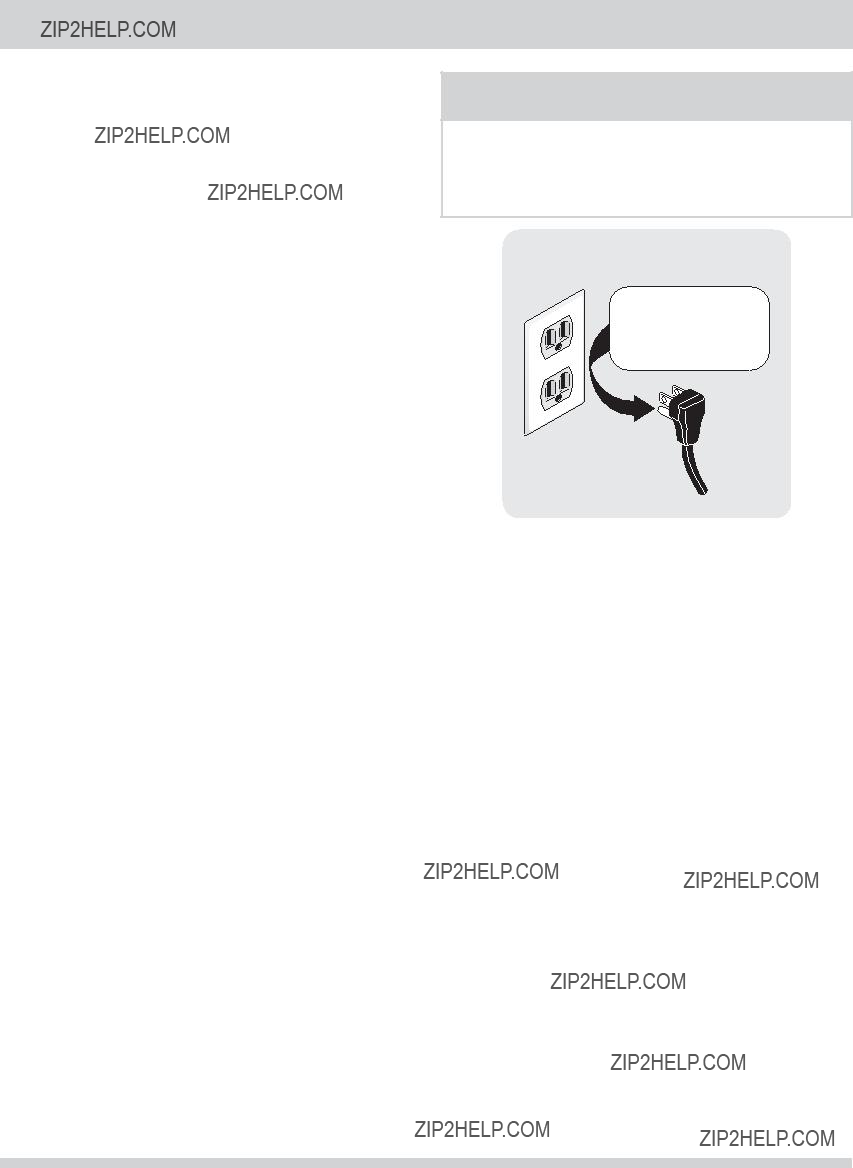
IMPORTANT SAFETY INSTRUCTIONS
???Do not continue to use the laundry center if you hear squeaking, grinding, rubbing or other unusual noises. This could be a sign of mechanical breakdown and lead to ???re or serious injury. Contact a quali???ed technician immediately.
???Failure to comply with these warnings could result in ???re, explosion, serious bodily injury and/or damage to the rubber or plastic parts of the laundry center.
PROTECT CHILDREN
???Do not allow children to play on or in the laundry cen- ter. Close supervision of children is necessary when the washer is used near children. As children grow, teach them the proper, safe use of all appliances.
???Destroy the carton, plastic bag and other packing mate- rials after the laundry center is unpacked. Children might use them for play. Cartons covered with rugs, bed- spreads or plastic sheets can become airtight chambers.
???Keep laundry products out of children???s reach. To pre- vent personal injury, observe all warnings on product labels.
???Before the laundry center is removed from service or discarded, remove the washer door to prevent acciden- tal entrapment.
???Failure to comply with these warnings could result in serious personal injuries.
PREVENT INJURY
???To prevent shock hazard and assure stability during operation, the laundry center must be installed and electrically grounded by a quali???ed service person in accordance with local codes. Installation instructions are packed in the washer for installer???s reference. Refer to INSTALLATION INSTRUCTIONS for detailed grounding procedures. If the laundry center is moved to a new location, have it checked and reinstalled by a quali???ed service person.
???To prevent personal injury or damage to the laundry center, the electrical power cord of a gas dryer must be plugged into a properly grounded and polarized

 WARNING
WARNING
FIRE/ELECTRICAL SHOCK HAZARD
Avoid ???re hazard or electrical shock. Do not use an adaptor plug or extension cord or remove grounding prong from electrical power cord. Failure to follow this warning can cause serious injury, ???re or death.
Grounding type wall receptacle
Do not, under
any circumstances, cut, remove,
or bypass the grounding prong.
Power cord with
???ALWAYS disconnect the laundry center from the electrical supply before attempting any service or cleaning. Failure to do so can result in electrical shock or injury.
???Do not use any type spray cleanser when cleaning dryer interior. Hazardous fumes or electrical shock could occur.
???To prevent injury, do not reach into the laundry center while parts are moving. Before loading, unloading or adding items, push in the cycle selector knob to stop the cycle. Allow the wash tub or dryer drum to coast to a complete stop before reaching inside.
4
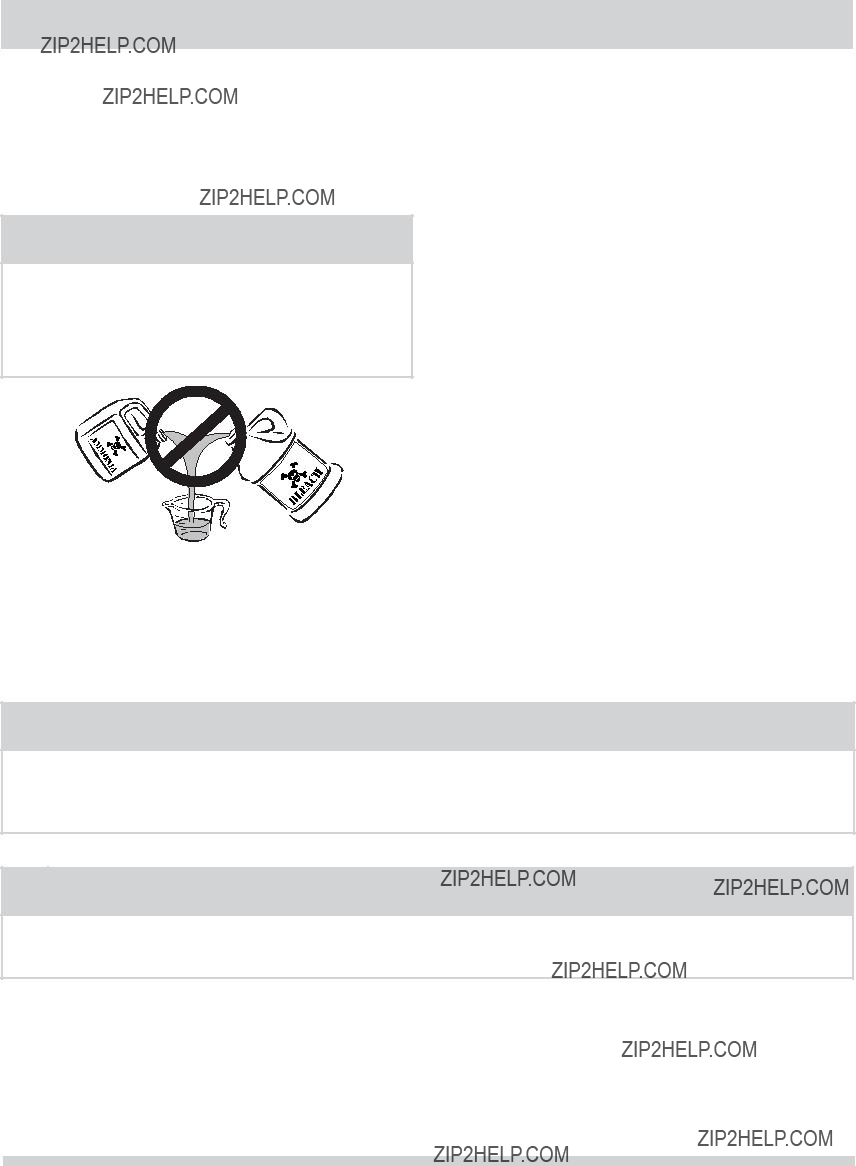
IMPORTANT SAFETY INSTRUCTIONS
???Follow package directions when using laundry products. Incorrect usage can produce poisonous gas - resulting in serious injury or death.
???Do not combine laundry products for use in 1 load un- less speci???ed on the label.
???Do not mix chlorine bleach with ammonia or acids such as vinegar.

 WARNING
WARNING
HARMFUL VAPOR HAZARD
Do not use or mix liquid chlorine bleach with other household chemicals such as toilet cleaners, rust removers, acid or products containing ammonia. These mixtures can produce dangerous fumes which can cause serious injury or death.
PREVENT INJURY AND DAMAGE TO THE APPLIANCE
To prevent serious personal injury and damage to the laundry center:
???All repairs and servicing must be performed by an au- thorized servicer unless speci???cally recommended in this Use & Care Guide. Use only authorized factory parts.
???Do not tamper with controls.
???Do not install or store the laundry center where it will be exposed to the weather.
???Do not install on carpet. Install laundry center on a solid ???oor. It may be necessary to reinforce the ???oor to prevent vibration or movement.
???Do not sit on, step on or stand on the laundry center. Do not rest heavy loads on top. The laundry center is not meant to support weight.
???To reduce the risk of electric shock, disconnect this appliance from the power supply before attempting any user maintenance. Canceling a cycle or turning the power off at the console does not disconnect this appli- ance from the power supply.
???This laundry center is equipped with an electrical over- load protector. The washer motor will stop if it becomes overheated.
???A thermal limiter switch automatically turns off the dryer motor in the unlikely event of an overheated situation. A service technician must replace the thermal limiter switch after correcting the fault.
???Failure to comply with these warnings could result in serious personal injuries.

 CAUTION
CAUTION
The California Safe Drinking Water and Toxic Enforcement Act requires the Governor of California to publish a list of substances known to the state to cause cancer, birth defects or other reproductive harm, and requires businesses to warn customer of potential exposure to such substances. Included in this list are soot and carbon monoxide, both of which may be produced by the use of this product.
NOTE
The instructions appearing in this Use and Care Guide are not meant to cover every possible condition and situa- tion that may occur. Common sense and caution must be practiced when installing, operating and maintaining any appliance.
5
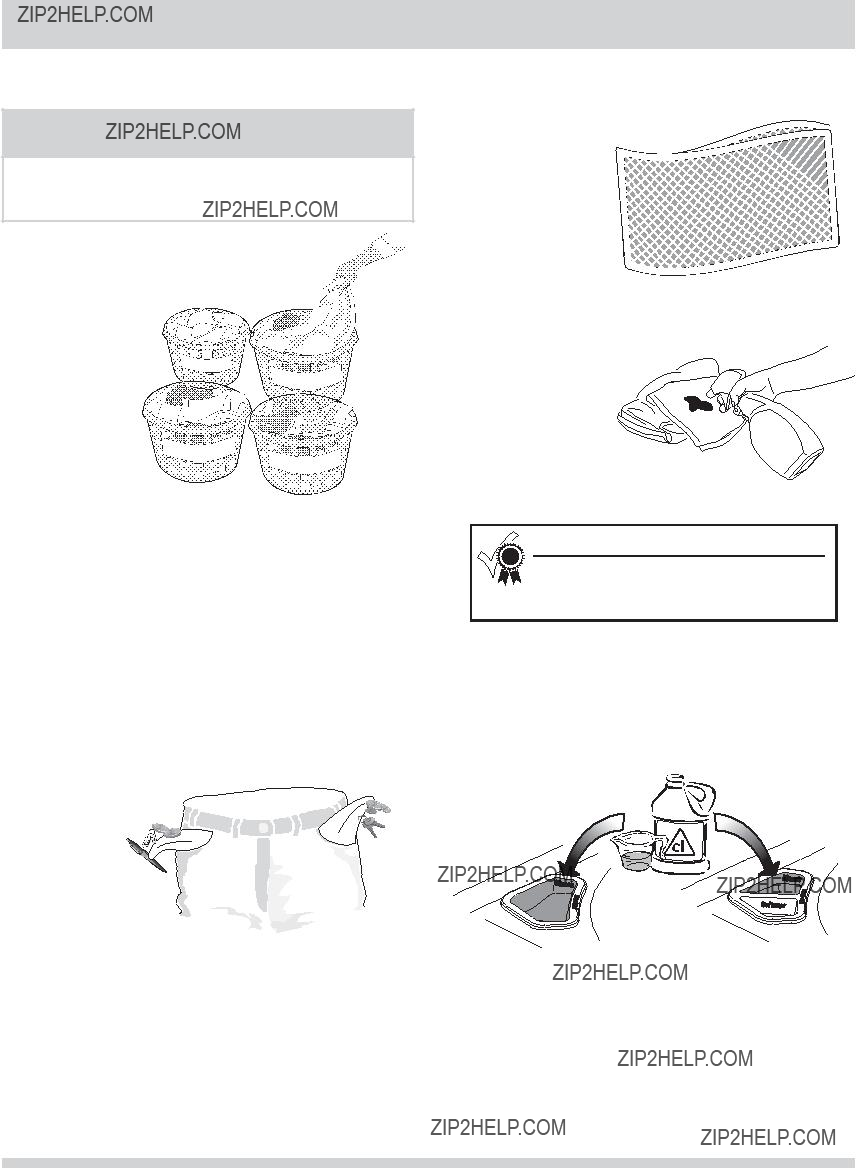
WASHER OPERATING INSTRUCTIONS
Washing Procedures

 WARNING
WARNING
To reduce the risk of ???re, electric shock or injury to persons, read these IMPORTANT SAFETY INSTRUCTIONS in this Use and Care Guide before operating your washer.
1 Sort laundry into loads that can be washed together.
WHITES
CASUAL
??? Separate white, light and colorfast items from dark and
??? Separate items that shed lint from items that attract lint. Casual, synthetic, knit, and cordu- roy items will pick up lint from towels, rugs, and bedspreads.
??? Separate heavily soiled items from lightly soiled items.
??? Separate lacy, sheer, loosely knit, or delicate items from durable items.
??? Do not machine wash items containing ???berglass. Small particles of ???berglass left in the drum may transfer to fabrics in other loads and cause skin irritation and/or damage to fabrics.
2Prepare items for washing.
???Empty pockets. 
??? Place delicate and small items such as bras, hosiery and baby socks in a  mesh bag.
mesh bag. 
(Mesh bag not included.)
3Pretreat stains and heavy soil.
???See Stain Removal Guide
in this guide for safe, successful stain removal instructions.
4Add a measured amount of detergent to the wash tub before adding the laundry load.
For best results
Use a 
???Follow detergent manufacturer???s directions. The amount required depends on type of detergent, load size and soil level, and water hardness.
5If desired, add liquid bleach to bleach dispenser.
???Before adding the wash load, add liquid bleach to bleach dispenser located in left front corner under the lid:
???Brush off lint and dirt. Shake out rugs and beach towels.
???Close zippers, fasten hooks, button buttons, tie strings and sashes, and remove
???Mend rips and tears to prevent further damage during washing.
???Turn knit items inside out to prevent pilling.
???Refer to bleach manufacturer???s directions for quan- tity to add.
???Then add 1 cup (240 ml) water to ???ush the dis- penser.
???Do not use powdered bleach in the bleach dispens- er. Add powdered bleach to the empty tub.
6
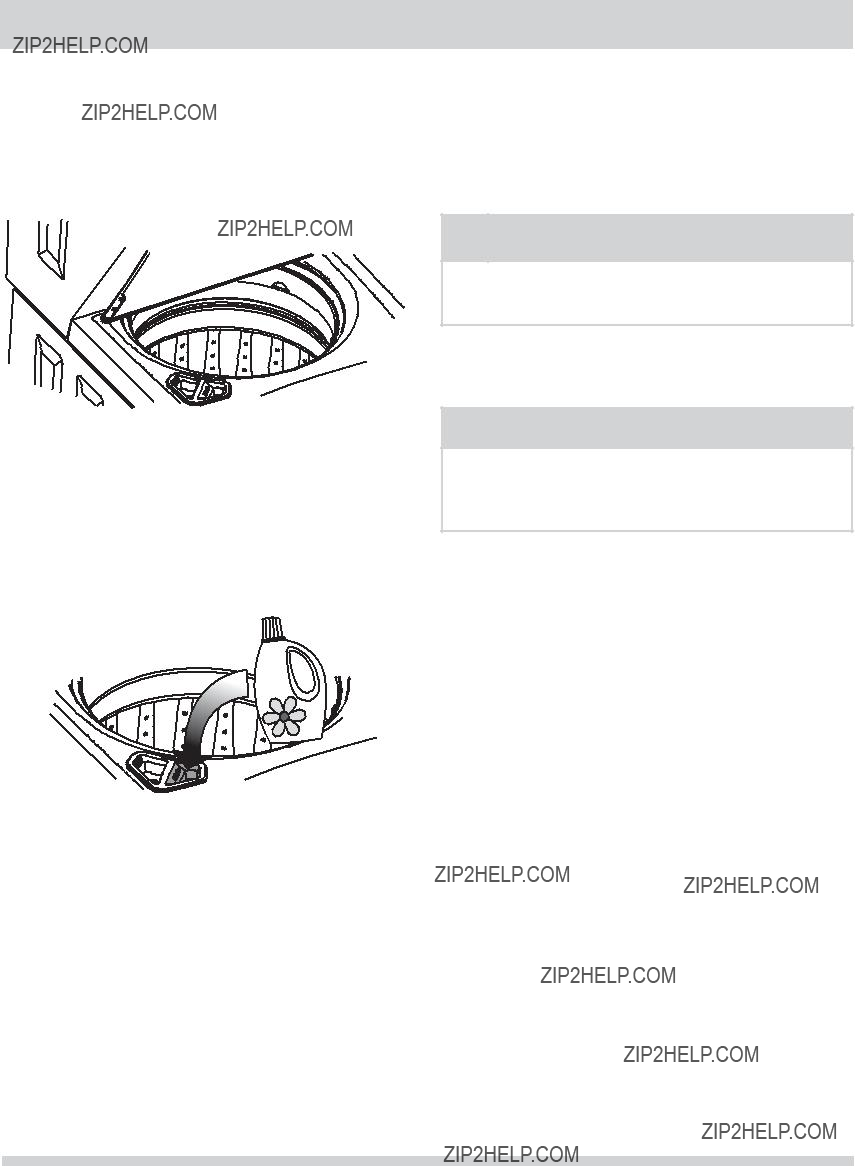
WASHER OPERATING INSTRUCTIONS
Washing Procedures, continued
6Add laundry load to washer.
???For best washing performance, dry load level should not be higher than the upper row of holes in the wash tub. Do not overload the washer.
For models without a
???Follow fabric softener label directions.
???Add diluted fabric softener to the ???nal rinse. You may use a fabric softener dispensing ball.
???Combine large and small items in a load. Load large items ???rst. Large items should not be more than half the total wash load.
???When washing a single heavy item, add 1 or 2 towels to balance the load.
7If desired, add liquid fabric softener to fabric softener dispenser (available on some models). For models with
???Add liquid softener to the dispenser, following fab- ric softener label directions. DO NOT use granular detergent in this dispenser.
???DO NOT ???ll above the maximum ???ll line.
???Turn fabric softener option on.
???Do not use bleach in this dispenser.
NOTE
To prevent staining, do not over???ll the ???FABRIC SOFTENER??? chamber or pour liquid fabric softener directly on the wash load.
Other Wash Products
???Water conditioner, detergent booster and enzyme products may be added with the detergent.

 IMPORTANT
IMPORTANT
Use of
8Select the appropriate cycle and settings for the load.
???See Washer Operating Instructions on following pages.
9Start the washer.
???Close the washer lid. The washer will not operate with the lid open.
???Push in or turn the cycle selector knob or turn any option knob to ???wake??? the washer. You will hear three beeps to indicate washer is ready to operate.
???After making your selections, push in the selector knob to start the cycle. You will hear one beep and the washer lid will lock.
???Unless a manual water level is selected (if avail- able), the washer will perform a dry load sensing procedure before adding water to the tub.
???To add a forgotten item to the wash tub, push in the cycle selector knob to pause the cycle. You will hear two beeps. After the lock releases, lift the lid and add the item. Close the lid and push in the selector knob again, continuing the current cycle.
???To stop a running cycle, push in the cycle selector knob.
7

WASHER OPERATING INSTRUCTIONS
Washing Procedures, continued
10 Remove items when the cycle is completed.
???For your safety, the lid is locked during the operation of the washer. It will unlock at the cycle end after the tub has come to a complete stop.
???Place washed items in automatic dryer, line dry, or dry ???at as directed by fabric care label. Excess wrin- kling, color transfer or odors may develop in items left in the washer after the cycle has ended.
For best results
Follow the fabric care label instructions on items to be washed.
SAFETY LID LOCK
???To open the lid during cycle operation, push in the cycle selector knob to pause the cycle. You will hear two beeps. Wait for the lid lock to release. Do not force open the locked lid.

 CAUTION
CAUTION
To avoid serious personal injury, do not operate washer if safety lid lock is missing, damaged or operating improperly.
8

WASHER OPERATING INSTRUCTIONS
This manual covers many models and not all cycles, options, or features listed are available on every model. Consoles shown above for reference only. Your model may differ.
Washing Cycle Selection
Turn the cycle selector in either direction to the cycle desired.
For best results
Follow the fabric care label instructions on items to be washed.
To change the cycle after it has begun, push in or turn the cycle selector knob to pause the current running cycle. Make the new selection and push in the cycle selector knob again to start the new cycle.
normal
Use this load for light to normally soiled cottons, towels, shirts, denims and mixed loads. For best combination of energy and water saving and washing performance, perform this cycle with energy saver option (if available) selected.
comforter (on select models only)
Add one large comforter or two
heavy duty
Use this cycle for heavily soiled, durable garments - ex. towels, sports gear, or fabric tote bags. For best soil and stain removal, use the hottest water safe for the fabrics being washed.
delicates
Use this cycle for lightly soiled knits and delicates which require gentle washing.
normal/heavy (on select models only)
Use this cycle for heavily soiled cottons, towels, shirts, denims and mixed loads.
bedding
This cycle is designed for large items such as blankets, sheets, mattress pads, duvet covers and similar items.
quick wash (on select models only)
Quickly wash a small, lightly soiled load in 25 minutes.
rinse & spin
Select rinse & spin for loads that need a cold water rinse or to add fabric softener that may have been omitted in a regular cycle.
presoak
Use this cycle to soak heavily soiled and stained items before washing. Any temperature may be selected, but cold water is recommended with this cycle as warmer water may set some stains. Use the amount of detergent recommended for a normal wash cycle. If desired, use a bleach or a soaking agent safe for the fabric. The washer will drain at the end of the cycle.
NOTE
Follow Presoak with a complete wash cycle suitable for the load using a half dose of detergent.
casual
Use this cycle for poly blends with a permanent press or
9
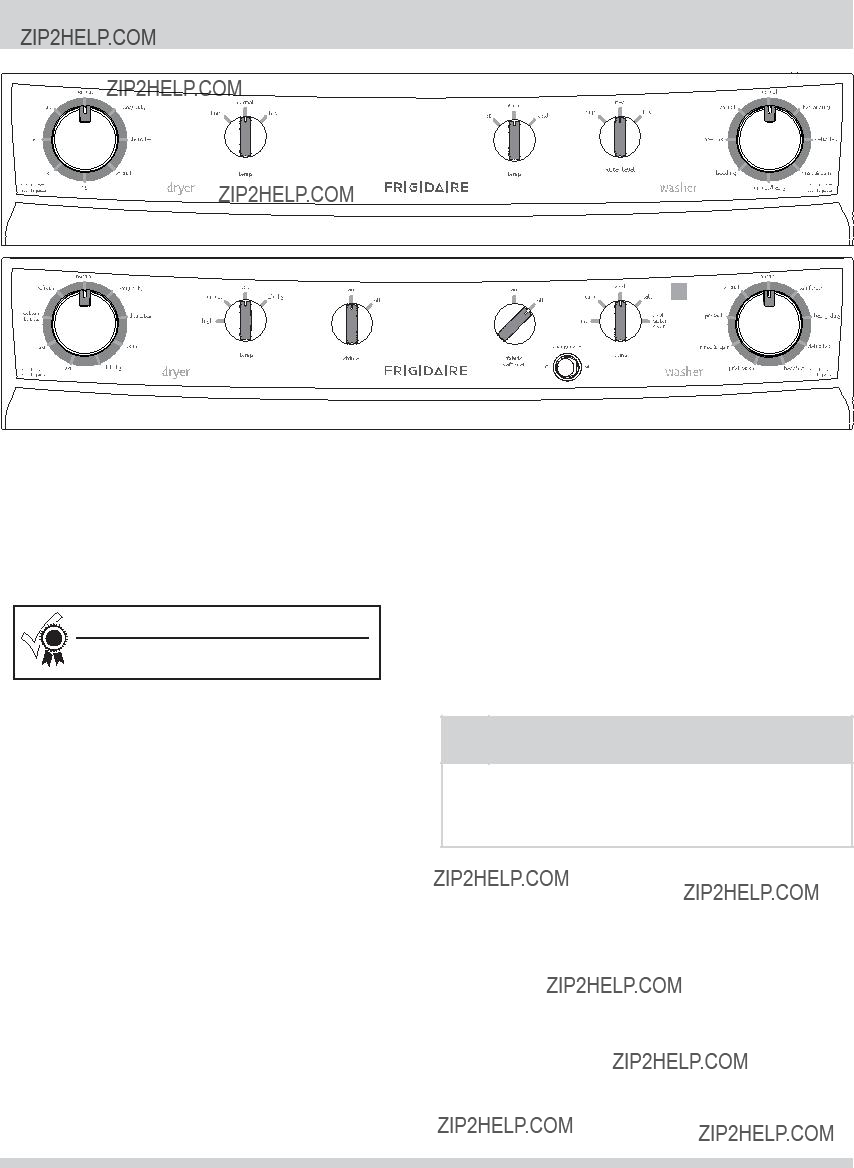
WASHER OPERATING INSTRUCTIONS
Washing Cycle Settings
Wash Water Temperature
Turn the temp knob until the desired wash water temperature is selected. Select a wash water temperature according to ???ber content, colorfastness and soil level. To protect your fabrics, the temperature range of cold to hot settings may be different depending on cycle selected.
For best results
Follow the fabric care label instructions on items to be washed.
The water heater setting and its distance from the washer, water usage in other parts of the home, and seasonally low ground water temperature in some geographic areas can affect water temperature.
hot
Use this setting for heavily soiled white or colorfast cottons and blends.
warm
Use this setting for normally soiled white or colorfast cottons or blends.
cool (on select models)
Use this setting for normally soiled sheets, casual items and washable woolens.
cold
Some warm water will automatically blend with cold tap supply to achieve cold. Use this setting for lightly soiled
cold water clean (on select models)
Wash and rinse temperatures are equivalent to temperature of cold tap supply. Use this selection for fabrics and colors that are prone to dye transfer. For use with cold water  detergents.
detergents.
Water Level (on select models, automatic on others)
Turn the water level knob (on select models) to select a water level appropriate for the load size. For best results, DO NOT overload. Add items loosely to the tub. The dry load should not be higher than the top row of holes in the wash tub. There should be enough water in the tub for items to move freely.
NOTE
If auto water level is selected, the washer will perform a dry load sensing procedure before adding water to the tub. Water level is automatically calculated by the washer on models without a water level knob.
Fabric Softener (on select models)
If your model is equipped with an automatic fabric softener dispenser, you must turn the fabric softener switch to the ???on??? position for correct operation. See Care and Cleaning for dispenser cleaning procedures.
Energy Saver (on select models)
The energy saver option reduces water temperature to save energy, lowers water usage slightly and also extracts more water to reduce drying time.
10
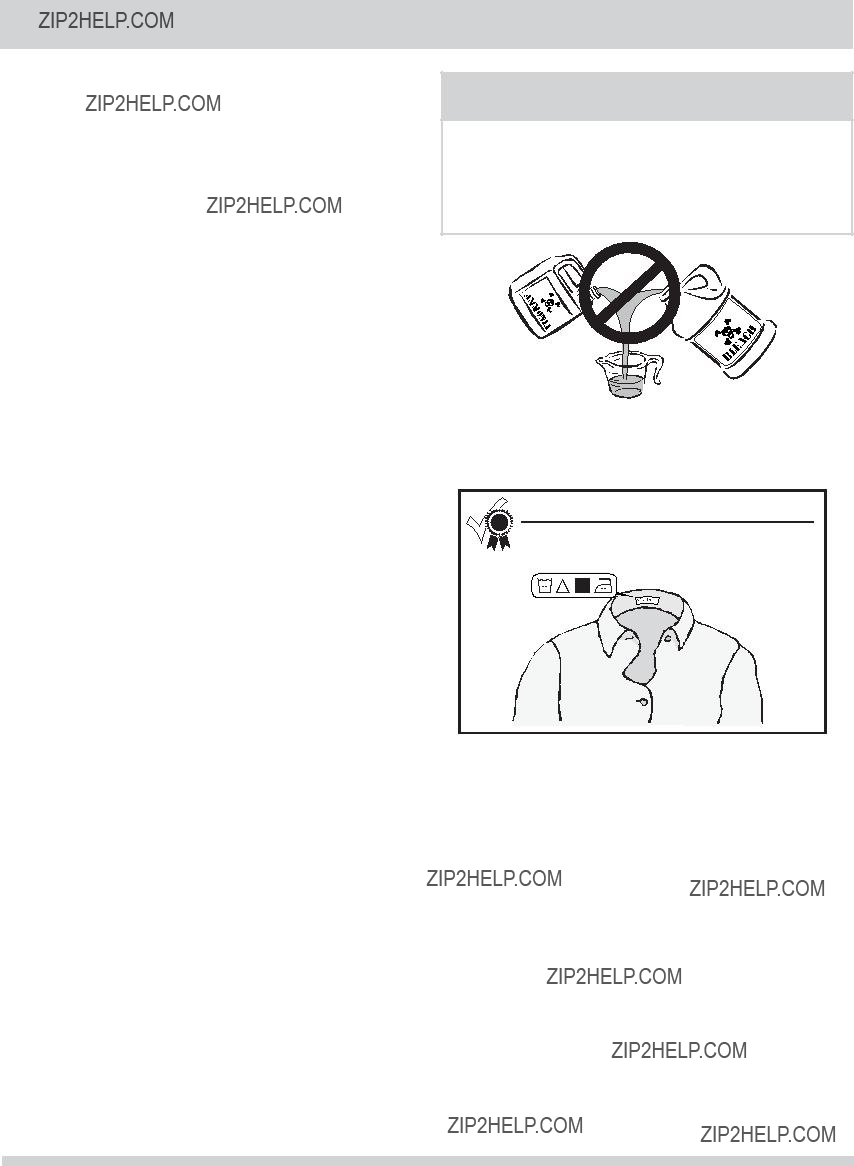
WASHER OPERATING INSTRUCTIONS
Safe Stain Removal Procedures
To reduce the risk of ???re or serious injury to persons or property, comply with the basic warnings listed below:
???Read and comply with all instructions on stain re- moval products.
???Keep stain removal products in their original labeled containers and out of children???s reach.
???Thoroughly wash any utensils used.
???Do not combine stain removal products, especially ammonia and chlorine bleach. Dangerous fumes can result.
???Never wash items which have been previously cleaned in, washed in, soaked in or spotted with gasoline, dry cleaning solvents or other ???ammable or explosive substances because they give off vapors that could ignite or explode.
???Never use highly ???ammable solvents, such as gaso- line, inside the home. Vapors can explode on contact with ???ames or sparks.

 WARNING
WARNING
HARMFUL VAPOR HAZARD
Do not use or mix liquid chlorine bleach with other household chemicals such as toilet cleaners, rust removers, acid or products containing ammonia. These mixtures can produce dangerous fumes which can cause serious injury or death.
For Successful Stain Removal:
???Remove stains promptly.
???Determine the kind of stain, then follow the recom- mended treatment in the stain removal chart on the next page.
???To pretreat stains, use a prewash product, liquid detergent, or a paste made from powder detergent and water.
???Use cold water on unknown stains as hot water can set stains.
???Consult care label instructions for treatments to avoid on speci???c fabrics.
???Check for colorfastness by testing stain remover prod- ucts on an inside seam.
???Rinse and wash items after stain removal.
For best results
Follow the fabric care label instructions on items to be washed.
11
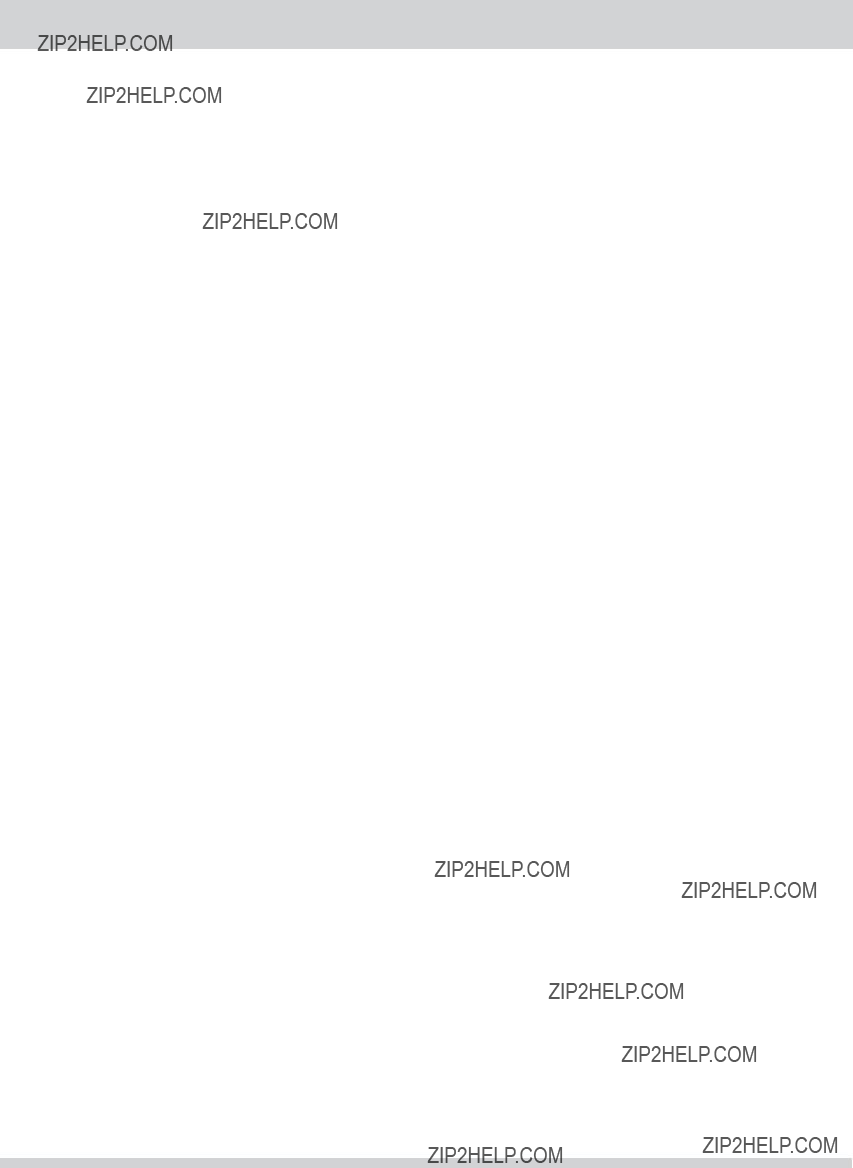
WASHER OPERATING INSTRUCTIONS
Stain Removal Suggestions
12
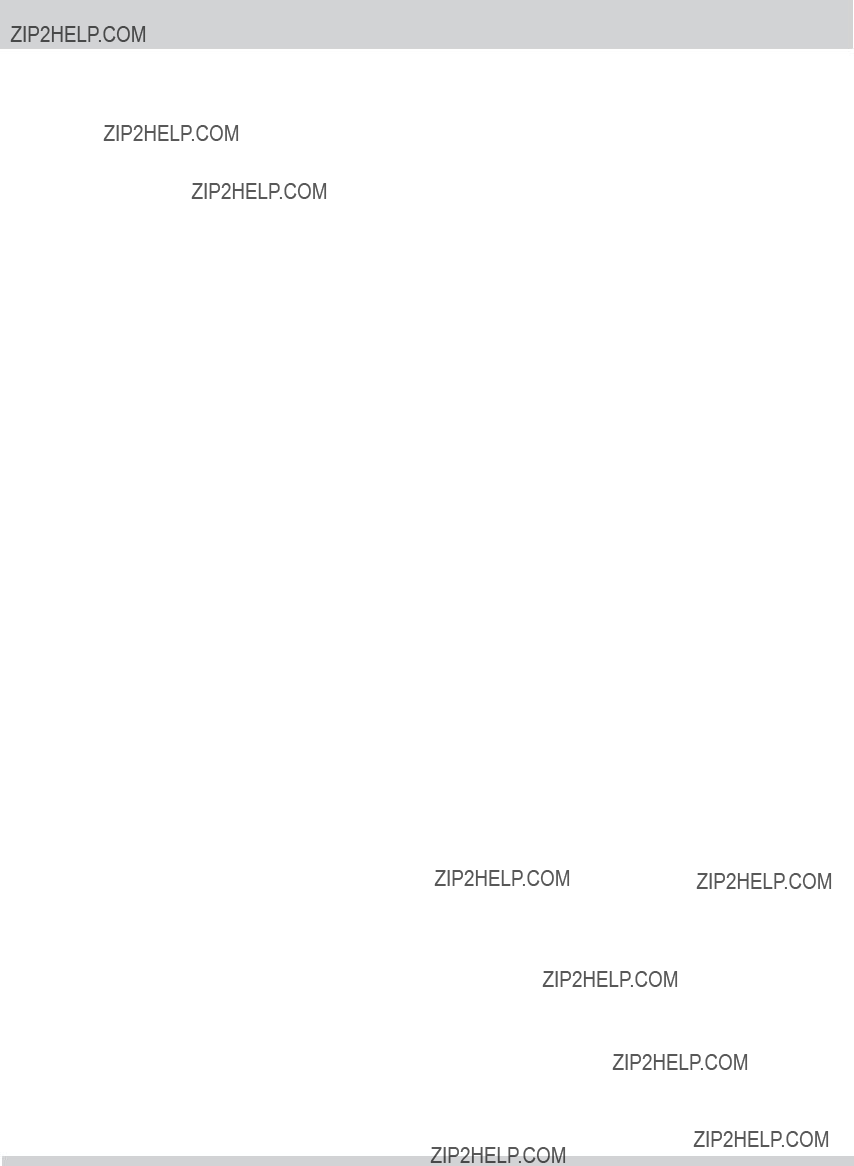
WASHER OPERATING INSTRUCTIONS
Common Washing Problems
Many washing problems involve poor soil and stain removal, residues of lint and scum, and fabric damage. For satisfactory washing results, follow these suggestions provided by The Soap and Detergent Association.
13
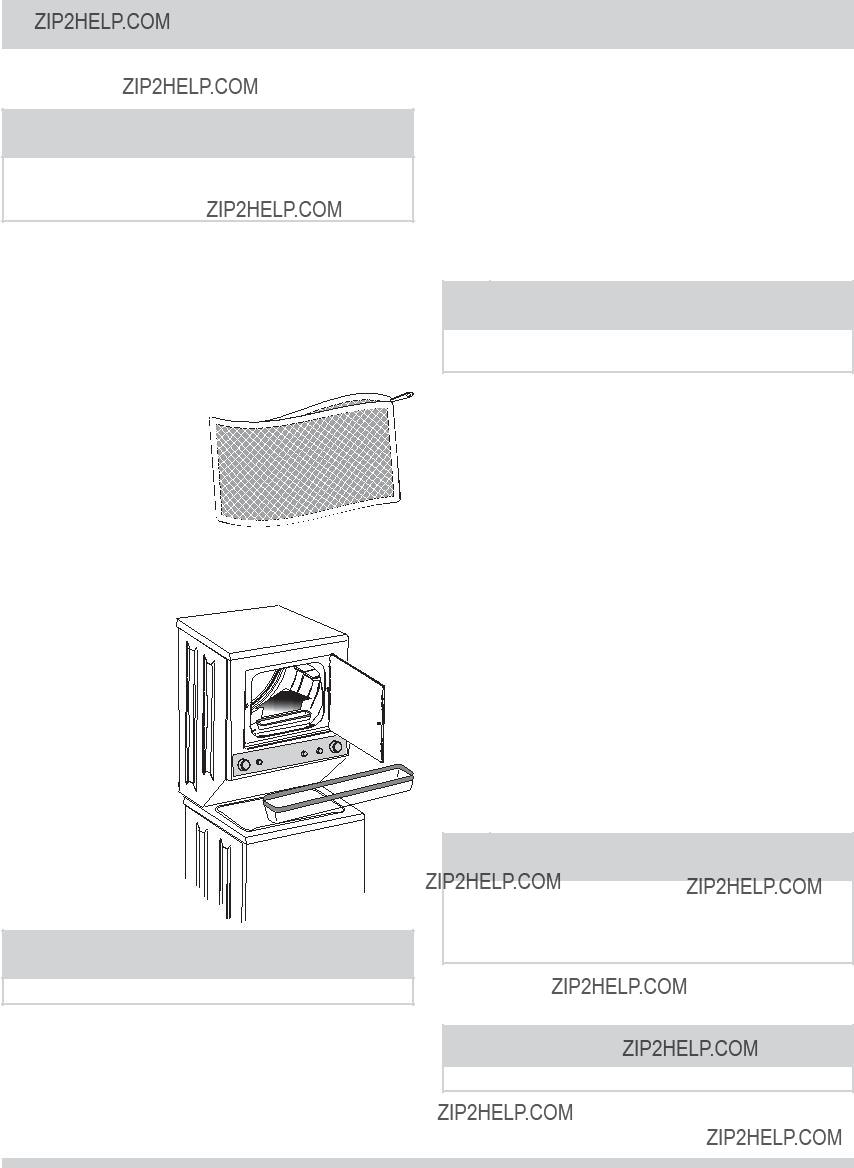
DRYER OPERATING INSTRUCTIONS
Drying Procedures

 WARNING
WARNING
To reduce the risk of ???re, electric shock or injury to persons, read the IMPORTANT SAFETY INSTRUCTIONS in this Use and Care Guide before operating your dryer.
1Prepare load for drying.
???Dry items of similar fabric, weight and construction in the same load.
???Separate dark items from
???Check for stains which may not have been removed in washing. Repeat stain removal process and wash again before drying. Dryer heat may permanently
set some stains.
??? Place delicate or small items in a mesh bag. 
??? Be sure buckles, buttons and trim are heatproof and won???t
damage the drum ???nish. Close zip-
pers, button buttons, fasten hooks and
2 Check that the lint ???lter is clean and in place.

 CAUTION
CAUTION
Do not operate dryer without lint ???lter in place.
3Load the dryer and close the door.
???Load items loosely. The average wet load will ???ll the drum 1/3 to 1/2 full. Items need room to tumble freely for even drying and less wrinkling.
???If desired, place a dryer fabric softener sheet on top of the load at the beginning of the cycle.
???To save energy and time and avoid uneven drying and wrinkling, do not overload the dryer.
???When drying large items, dry only two or three items at a time. Fill out the load with small and medium sized items.
???For delicate or very small loads, add two or three similar items to improve tumbling action.
NOTE
4Select the appropriate cycle and settings for each load.
???See Dryer Operating Instructions on following pages.
5Start the dryer.
???Close the dryer door. The dryer will not operate with the door open.
???Push in or turn the cycle selector knob or turn any option knob to ???wake??? the dryer. You will hear three beeps to indicate dryer is ready to operate.
???After making your selections, push in the selector knob to start the cycle. You will hear one beep before the drum begins to rotate.
???To add or remove items when the dryer is running, push in the cycle selector knob to pause the cycle and open the door. Opening the door with a cycle running will also pause the cycle. You will hear two beeps. Allow the drum to come to a complete stop before reaching inside. Add or remove the item, close the door and push in the selector knob again, continuing the current cycle.
???To stop a running cycle, push in the cycle selector knob.
NOTE
If drying a single large or bulky item, such as a comforter, remove the item part way through the cycle and turn it ???inside out??? to maximize drying effectiveness. Place item back in dryer and
6When the cycle ends, remove items immedi- ately and hang or fold.

 IMPORTANT
IMPORTANT
Clean the lint ???lter after every load.
14
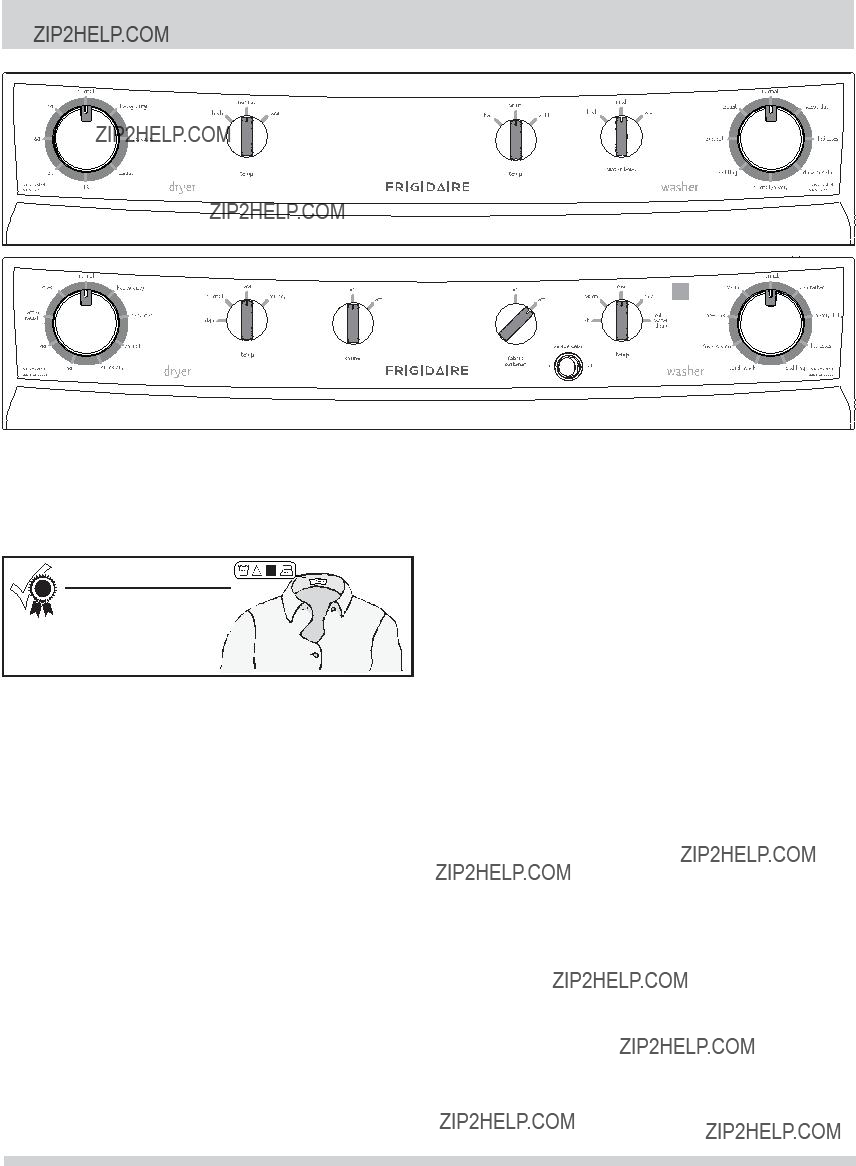
DRYER OPERATING INSTRUCTIONS
This manual covers many models and not all cycles, options, or features listed are available on every model. Consoles shown above for reference only. Your model may differ.
Drying Cycle Selection
Turn the cycle selector in either direction to the cycle desired.
For best results
Follow the fabric care label instructions on items to be dried.
To change the cycle after it has begun, push in or turn the cycle selector knob to pause the current running cycle. Make the new selection and push in the cycle se- lector knob again to start the new cycle.
Auto Dry Cycles
Auto Dry cycles take the guesswork out of selecting the correct drying time for each load. Moisture sensing bars in the front of the dryer drum (on certain models) sense the moisture level of the load as it tumbles through the heated air. With Auto Dry cycles, the load will automatically be dried at the selected temperature to a speci???c dryness level. Auto Dry cycles save time and energy and protect fabrics.
When the load has reached the dryness level, it will continue to tumble during a cool down period. This helps reduce wrinkling and makes items easier to handle during unloading.
Drying time varies depending on size and dampness of load and fabric type. If the load is too small or almost dry, the moisture sensing bars may not detect enough moisture to continue the cycle and the cycle may end after a few minutes. If this occurs, select a Timed Dry cycle.
Room temperature and humidity, type of installation and electrical voltage or gas pressure can also affect drying time.
normal
Select this cycle to dry everyday fabrics including cottons, linens and sheets.
heavy duty
Select this Auto Dry cycle to dry durable fabrics such as work wear and overalls.
delicates
Select this cycle to dry knits and delicates.
casual
Select this cycle to dry cottons, blends and permanent press items with a
cotton towels (on select models)
Select this cycle to dry heavy loads such as towels and
15
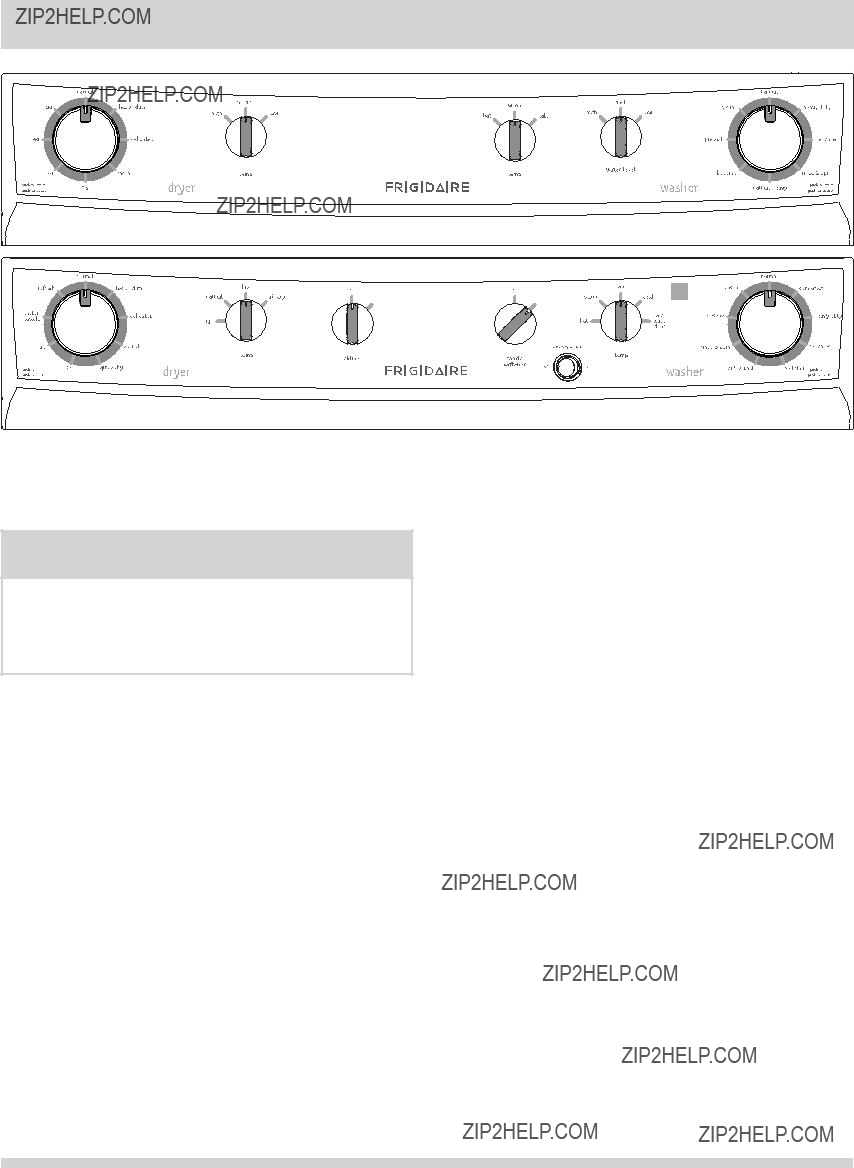
DRYER OPERATING INSTRUCTIONS
Drying Cycle Selection, continued
Timed Dry Cycles

 WARNING
WARNING
FIRE HAZARD
To avoid ???re hazard, do not use heat to dry items containing feathers or down, foam rubber, plastics similarly textured,
quick dry (on select models only)
Select this timed cycle to quickly dry a small load made up of just a few items. It provides approximately 20 minutes of tumbling followed by a cool down period.
refresh (on select models only)
Select refresh to help remove wrinkles from clean and dry items that were not taken from the dryer at the end of the cycle, have been stored in crowded closets or drawers, or unpacked from luggage following a
trip. It provides approximately 10 minutes of tumbling followed by a
timed dry
To manually select the drying time for any load, turn the knob to a numbered setting: 15 (on select models), 30, 60, or 90 minutes. Moisture sensing bars (if equipped) are not active and dryer will continue to heat throughout the cycle until the ???nal cool down period.
Drying Cycle Settings
Drying Temperature
Select the temperature setting most suitable for each load. To protect your fabrics, not all temperatures are available with every cycle. If an unavailable temperature setting is selected by the user, the nearest available temperature will be substituted.
The air dry (on select models) setting can be used only in a timed cycle. Air dry setting tumbles the load without heat. Use air dry to freshen clothing, pillows or blankets, or to dust draperies.
Chime (on select models)
A signal will sound at the end of the cycle if selected.
16

DRYER OPERATING INSTRUCTIONS
Other Features
Drying Rack (some models)
Use the drying rack to dry items which should not be tumble dried. If your model did not come with a drying rack, you may order one.
Place the front bar under the lip of the lint screen opening.
1.Open the dryer door and remove the lint screen.
2.Insert drying rack into the dryer drum. Place the front bar under the lip of the lint screen opening.
3.Place items to be dried on top of the rack. Weight should not exceed 10 lbs. Leave space between items, but do not let items hang over the sides or through the grids. Do not tumble other items when using the drying rack.
4.Select a timed cycle. If items to be dried contain plastic, foam rubber,
5.When items are dry, remove the rack and replace the lint screen. If lint screen is not in place, tumbling items could enter the exhaust system and cause damage to the dryer.
Common Drying Problems
Many drying problems involve poor cleaning results, poor soil and stain removal, residues of lint and scum, and fabric damage. For satisfactory drying results, follow these suggestions provided by The Soap and Detergent Association.
17
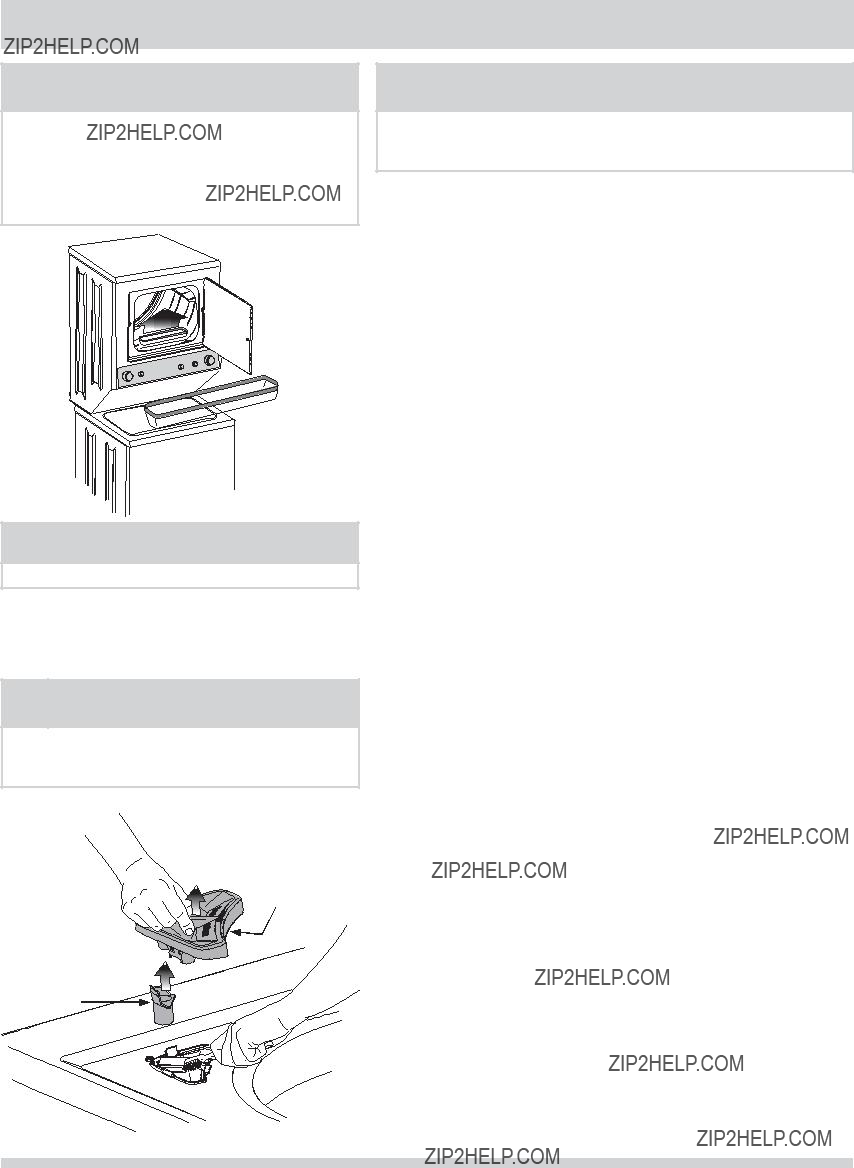
CARE AND CLEANING

 WARNING
WARNING
FIRE HAZARD
A clothes dryer produces combustible lint. The dryer must be connected to an outdoors exhaust. Regularly inspect the outdoor exhaust opening and remove any accumulation of lint
around the opening and in the surrounding area.

 IMPORTANT
IMPORTANT
Clean the lint ???lter after every load.
NOTE
Fabric softener may build up in the dispenser well. Residue should be removed once or twice a month.
a
b

 WARNING
WARNING
To reduce risk of ???re or serious injury to persons or property, comply with the basic warnings listed in the Important Safety Instructions and those listed below.
???Before cleaning the laundry center interior, unplug the electrical power cord to avoid electrical shock hazards.
???Do not use any type spray cleanser when cleaning the dryer interior. Hazardous fumes or electrical shock could occur.
INSIDE DRYER
???Clean the lint ???lter after every load. Lint
???Occasionally a waxy
???If the dryer drum becomes stained from noncolorfast fabrics, clean the drum with a damp cloth and a mild liquid household cleanser. Remove cleanser residue before drying the next load.
???Every 18 months an authorized servicer should clean the dryer cabinet interior and exhaust duct. These areas can collect lint and dust over time. An excessive amount of lint
INSIDE WASHER
???Remove items from the washer as soon as the cycle ends. Excess wrinkling, color transfer, and odors may develop in items left in the washer.
???Dry the washer top, the area around the lid opening, and the underside of the lid. These areas should always be dry before the lid is closed.
???Before cleaning the washer interior, unplug the electrical power cord to avoid electrical shock hazards.
???When extremely soiled items have been washed, a dirty residue may remain on the tub. Remove this by wiping the tub with a nonabrasive household cleanser. Rinse thoroughly with water.
???The base plate or tub may become stained from fabric dye. Clean these parts with a nonabrasive household cleanser. This prevents dye transfer to future loads.
FABRIC SOFTENER DISPENSER
???Remove the dual chamber insert (a) from the bleach and fabric softener dispenser by pinching at the chamber divider and lifting upward. Also remove the siphon cap (b).
???Rinse the insert and cap with a combination of ?? cup liq- uid chlorine bleach and 1 gallon hot tap water to remove any buildup. Large amounts of fabric softener residue may indicate improper dilution or more frequent cleaning is required. Rinse well with tap water.
???For the dispenser well, use a small brush to clean the recesses. Remove all residue.
???Replace the siphon cap and insert by pressing it in place until you hear a slight click.
18

CARE AND CLEANING
Cleaning Instructions, continued
OUTSIDE
??? When washing is completed, wipe top and sides of laundry center with a damp cloth. Turn water faucets off to prevent pressure
??? Clean the cabinet with mild soap and water. Never use harsh, gritty or abrasive cleansers
???If the cabinet becomes stained, clean with diluted chlorine bleach (1 part bleach to 8 parts water). Rinse several times with clear water.
??? Remove glue residue from tape or labels with a mixture of warm water and mild detergent. Or, touch residue with the sticky side of tape.
??? Before moving the laundry center, place a strip of card- board or thin ???berboard under the front leveling legs to prevent damage to the ???oor.

 IMPORTANT
IMPORTANT
Do not store or place laundry products on top of laundry center at any time. They can damage the ???nish or controls.
Winterizing Instructions

 IMPORTANT
IMPORTANT
If the laundry center is stored in an area where freezing can occur or moved in freezing temperatures, follow these winterizing instructions to prevent damage to the washer:
1Turn off water supply faucets.
2Disconnect hoses from water supply and drain water from hoses.
3Plug electrical cord into a properly grounded electrical outlet.
4Add 1 gallon (3.8 L) nontoxic recreational vehicle (RV) antifreeze to empty wash drum. Close door.
5Select the rinse & spin cycle. Start the cycle and let the washer drain for 1 minute to drain out all the water. Not all of the RV antifreeze will be expelled.
6Stop the cycle, unplug electrical power cord, dry off tub interior and close the lid.
7Store laundry center in an upright position.
8To remove antifreeze from washer after storage, run empty washer through a complete cycle using detergent.
Do not add wash load.
RV ANTIFREEZE
Follow WINTERIZING INSTRUCTIONS for cold weather storage and care.
19
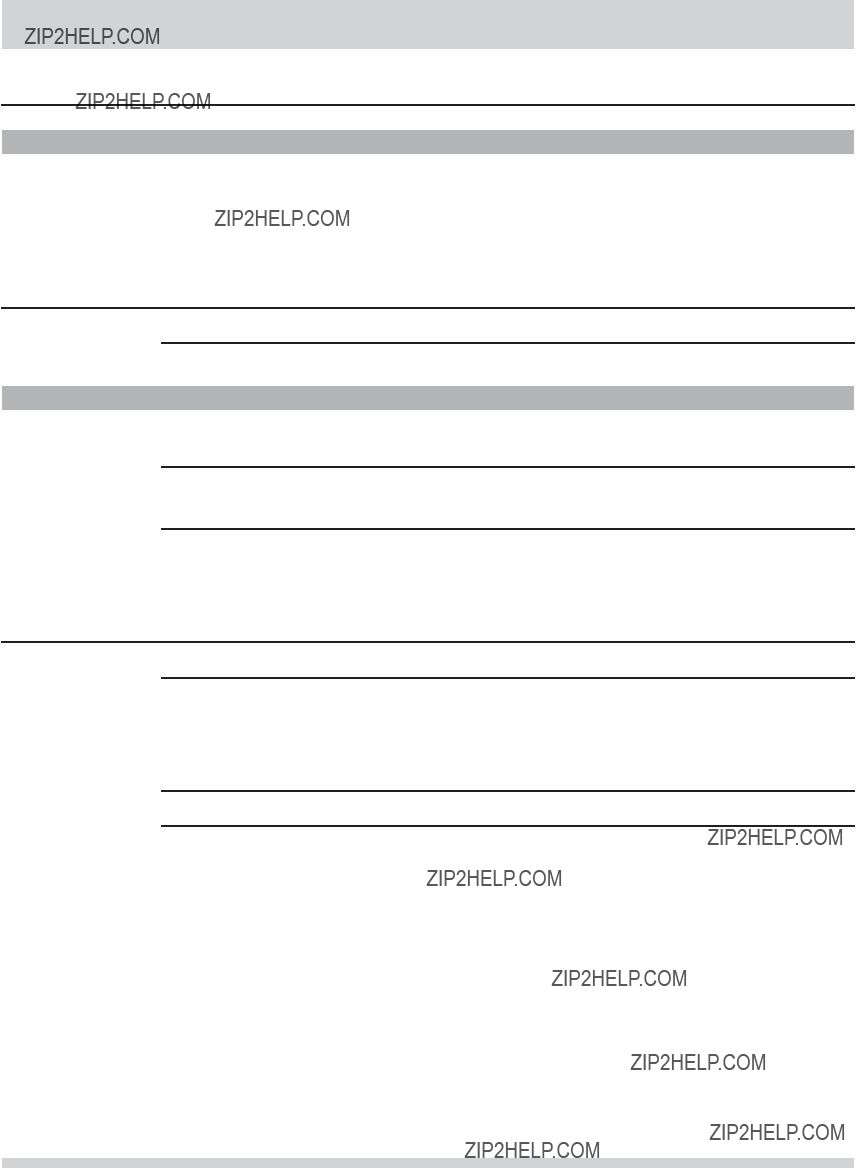
AVOID SERVICE CHECKLIST
Before calling for service, review this list. It may save both time and expense. The list includes common occurrences that are not the result of defective workmanship or materials in this laundry center.
Move washer so it rests ???rmly on ???oor. Adjust leveling legs. See INSTALLATION INSTRUCTIONS for details.
House fuse blown, circuit breaker tripped, or a power outage has occurred.
Reset circuit breaker or replace fuse. Do not increase fuse capacity. If problem is a circuit overload, have it corrected by a quali???ed electrician. If problem is a power outage, call local electric company.
Make sure the plug ???ts tightly in wall outlet.
Gas supply valve is not open (gas models).
Check to make sure supply valve is open. See INSTALLATION INSTRUCTIONS for procedure.
20
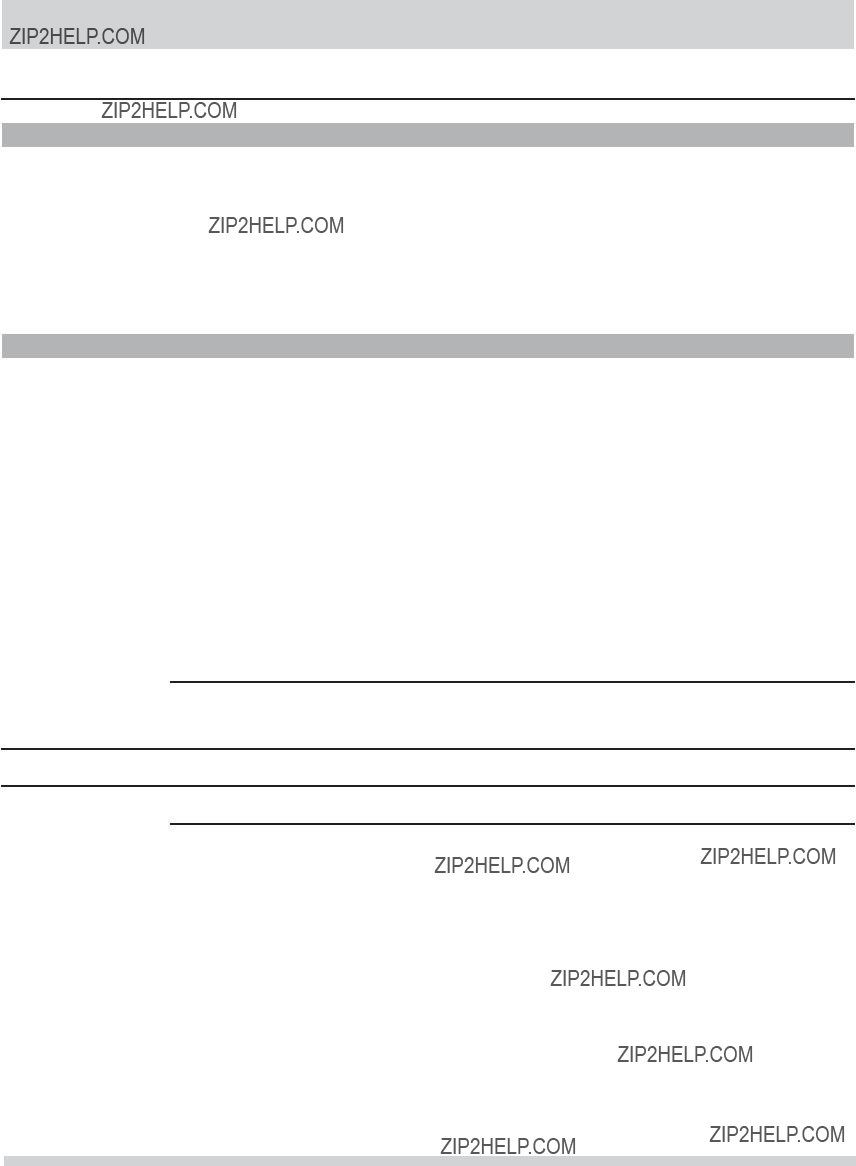
AVOID SERVICE CHECKLIST
Hot water is being used elsewhere in the house.
Avoid using hot water elsewhere before or during washer use. There may not be enough hot water available for proper clean- ing. If problem persists, your hot water system may be unable to support more than 1 use at a time.
Water in washer does not drain or drains slowly.
Drain hose is kinked or clogged.
Clean and straighten the drain hose.
Check and tighten hose connections. Install rubber sealing washers provided.
21

MAJOR APPLIANCE WARRANTY INFORMATION
For the applicable warranty period as set forth below, as measured from your original date of purchase, Electrolux will repair or replace any parts of this appliance that prove to be defective in materials or workmanship when such appliance is installed, used and maintained in accordance with the provided instructions.
Warranty Periods:
???All parts ??? One year including labor
???Wash tub ??? Functional life of the product (excluding labor)
???Wash tub drive motor,
Exclusions
This warranty does not cover the following:
1.Products with original serial numbers that have been removed, altered or cannot be readily determined.
2.Product that has been transferred from its original owner to another party or removed outside the USA or Canada.
3.Rust on the interior or exterior of the unit.
4.Products purchased
5.Food loss due to any refrigerator or freezer failures.
6.Products used in a commercial setting.
7.Service calls which do not involve malfunction or defects in materials or workmanship, or for appliances not in ordinary household use or used other than in accordance with the provided instructions.
8.Service calls to correct the installation of your appliance or to instruct you how to use your appliance.
9.Expenses for making the appliance accessible for servicing, such as removal of trim, cupboards, shelves, etc., which are not a part of the appliance when it is shipped from the factory.
10.Service calls to repair or replace appliance light bulbs, air ???lters, water ???lters, other consumables, or knobs, handles, or other cosmetic parts.
11.Surcharges including, but not limited to, any after hour, weekend, or holiday service calls, tolls, ferry trip charges, or mileage expense for service calls to remote areas, including the state of Alaska.
12.Damages to the ???nish of appliance or home incurred during installation, including but not limited to ???oors, cabinets, walls, etc.
13.Damages caused by: services performed by unauthorized service companies; use of parts other than genuine Electrolux parts or parts obtained from persons other than authorized service companies; or external causes such as abuse, misuse, inadequate power supply, accidents, ???res, or acts of God.
DISCLAIMER OF IMPLIED WARRANTIES; LIMITATION OF REMEDIES
CUSTOMER???S SOLE AND EXCLUSIVE REMEDY UNDER THIS LIMITED WARRANTY SHALL BE PRODUCT REPAIR OR REPLACEMENT AS
PROVIDED HEREIN. CLAIMS BASED ON IMPLIED WARRANTIES, INCLUDING WARRANTIES OF MERCHANTABILITY OR FITNESS FOR
A PARTICULAR PURPOSE, ARE LIMITED TO ONE YEAR OR THE SHORTEST PERIOD ALLOWED BY LAW, BUT NOT LESS THAN ONE
YEAR. ELECTROLUX SHALL NOT BE LIABLE FOR CONSEQUENTIAL OR INCIDENTAL DAMAGES SUCH AS PROPERTY DAMAGE AND
INCIDENTAL EXPENSES RESULTING FROM ANY BREACH OF THIS WRITTEN LIMITED WARRANTY OR ANY IMPLIED WARRANTY.
SOME STATES AND PROVINCES DO NOT ALLOW THE EXCLUSION OR LIMITATION OF INCIDENTAL OR CONSEQUENTIAL DAMAGES,
OR LIMITATIONS ON THE DURATION OF IMPLIED WARRANTIES, SO THESE LIMITATIONS OR EXCLUSIONS MAY NOT APPLY TO
YOU. THIS WRITTEN WARRANTY GIVES YOU SPECIFIC LEGAL RIGHTS. YOU MAY ALSO HAVE OTHER RIGHTS THAT VARY FROM
STATE TO STATE.
IF YOU NEED SERVICE
Keep your receipt, delivery slip, or some other appropriate payment record to establish the warranty period should service be required. If service is performed, it is in your best interest to obtain and keep all receipts. Service under this warranty must be obtained by contacting Electrolux at the addresses or phone numbers below.
This warranty only applies in the USA and Canada. In the USA, your appliance is warranted by Electrolux Major Appliances North America, a division of Electrolux Home Products, Inc. In Canada, your appliance is warranted by Electrolux Canada Corp. Electrolux authorizes no person to change or add to any obligations under this warranty. Obligations for service and parts under this warranty must be performed by Electrolux or an authorized service company. Product features or speci???cations as described or illustrated are subject to change without notice.
22